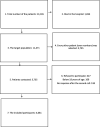Risk Factors Associated with Long COVID Syndrome: A Retrospective Study
- PMID: 34840383
- PMCID: PMC8611223
- DOI: 10.30476/ijms.2021.92080.2326
Risk Factors Associated with Long COVID Syndrome: A Retrospective Study
Abstract
Background: Recently, people have recognized the post-acute phase symptoms of the COVID-19. We investigated the long-term symptoms associated with COVID-19, (Long COVID Syndrome), and the risk factors associated with it.
Methods: This was a retrospective observational study. All the consecutive adult patients referred to the healthcare facilities anywhere in Fars province from 19 February 2020 until 20 November 2020 were included. All the patients had a confirmed COVID-19 diagnosis. In a phone call to the patients, at least three months after their discharge from the hospital, we obtained their current information. The IBM SPSS Statistics (version 25.0) was used. Pearson Chi square, Fisher's exact test, t test, and binary logistic regression analysis model were employed. A P value of less than 0.05 was considered to be significant.
Results: In total, 4,681 patients were studied, 2915 of whom (62.3%) reported symptoms. The most common symptoms of long COVID syndrome were fatigue, exercise intolerance, walking intolerance, muscle pain, and shortness of breath. Women were more likely to experience long-term COVID syndrome than men (Odds Ratio: 1,268; 95% Confidence Interval: 1,122-1,432; P=0.0001), which was significant. Presentation with respiratory problems at the onset of illness was also significantly associated with long COVID syndrome (Odds Ratio: 1.425; 95% Confidence Interval: 1.177-1.724; P=0.0001). A shorter length of hospital stay was inversely associated with long COVID syndrome (Odds Ratio: 0.953; 95% Confidence Interval: 0.941-0.965; P=0.0001).
Conclusion: Long COVID syndrome is a frequent and disabling condition and has significant associations with sex (female), respiratory symptoms at the onset, and the severity of the illness.
Keywords: COVID-19; Medicine; SARS-CoV-2; Viruses.
Copyright: © Iranian Journal of Medical Sciences.
Figures
References
-
- Walitt B, Bartrum E. A clinical primer for the expected and potential post-COVID-19 syndromes. Pain Rep. 2021;6:e887. doi: 10.1097/PR9.0000000000000887. [ PMC Free Article ] - DOI - PMC - PubMed
-
- Kordzadeh-Kermani E, Khalili H, Karimzadeh I. Pathogenesis, clinical manifestations and complications of coronavirus disease 2019 (COVID-19) Future Microbiol. 2020;15:1287–305. doi: 10.2217/fmb-2020-0110. [ PMC Free Article ] - DOI - PMC - PubMed
-
- Arnold DT, Hamilton FW, Milne A, Morley AJ, Viner J, Attwood M, et al. Patient outcomes after hospitalisation with COVID-19 and implications for follow-up: results from a prospective UK cohort. Thorax. 2021;76:399–401. doi: 10.1136/thoraxjnl-2020-216086. [ PMC Free Article ] - DOI - PMC - PubMed
-
- Raveendran AV. Long COVID-19: Challenges in the diagnosis and proposed diagnostic criteria. Diabetes Metab Syndr. 2021;15:145–6. doi: 10.1016/j.dsx.2020.12.025. [ PMC Free Article ] - DOI - PMC - PubMed
-
- NICE Guidance [Internet] National Institute for Health and Care Excellence. [published 2020 Dec 18; cited 2021 June 18] Available from: https://www.nice.org.uk/guidance/ng188/
Publication types
MeSH terms
LinkOut - more resources
Full Text Sources
Medical
Miscellaneous

